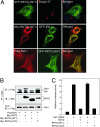Spatial regulation of Raf kinase signaling by RKTG
- PMID: 17724343
- PMCID: PMC1964828
- DOI: 10.1073/pnas.0701298104
Spatial regulation of Raf kinase signaling by RKTG
Abstract
Subcellular compartmentalization has become an important theme in cell signaling such as spatial regulation of Ras by RasGRP1 and MEK/ERK by Sef. Here, we report spatial regulation of Raf kinase by RKTG (Raf kinase trapping to Golgi). RKTG is a seven-transmembrane protein localized at the Golgi apparatus. RKTG expression inhibits EGF-stimulated ERK and RSK phosphorylation, blocks NGF-mediated PC12 cell differentiation, and antagonizes Ras- and Raf-1-stimulated Elk-1 transactivation. Through interaction with Raf-1, RKTG changes the localization of Raf-1 from cytoplasm to the Golgi apparatus, blocks EGF-stimulated Raf-1 membrane translocation, and reduces the interaction of Raf-1 with Ras and MEK1. In RKTG-null mice, the basal ERK phosphorylation level is increased in the brain and liver. In RKTG-deleted mouse embryonic fibroblasts, EGF-induced ERK phosphorylation is enhanced. Collectively, our results reveal a paradigm of spatial regulation of Raf kinase by RKTG via sequestrating Raf-1 to the Golgi apparatus and thereby inhibiting the ERK signaling pathway.
Conflict of interest statement
The authors declare no conflict of interest.
Figures





Similar articles
-
RKTG sequesters B-Raf to the Golgi apparatus and inhibits the proliferation and tumorigenicity of human malignant melanoma cells.Carcinogenesis. 2008 Jun;29(6):1157-63. doi: 10.1093/carcin/bgn119. Epub 2008 May 29. Carcinogenesis. 2008. PMID: 18515281
-
Suppressive function of RKTG on chemical carcinogen-induced skin carcinogenesis in mouse.Carcinogenesis. 2008 Aug;29(8):1632-8. doi: 10.1093/carcin/bgn139. Epub 2008 Jun 10. Carcinogenesis. 2008. PMID: 18550569
-
Functional cooperation of RKTG with p53 in tumorigenesis and epithelial-mesenchymal transition.Cancer Res. 2011 Apr 15;71(8):2959-68. doi: 10.1158/0008-5472.CAN-10-4077. Epub 2011 Mar 8. Cancer Res. 2011. PMID: 21385899
-
KSR and CNK: two scaffolds regulating RAS-mediated RAF activation.Oncogene. 2007 May 14;26(22):3143-58. doi: 10.1038/sj.onc.1210408. Oncogene. 2007. PMID: 17496912 Review.
-
Role of lipids in the MAPK signaling pathway.Prog Lipid Res. 2006 Mar;45(2):102-19. doi: 10.1016/j.plipres.2005.12.003. Epub 2006 Jan 18. Prog Lipid Res. 2006. PMID: 16455141 Review.
Cited by
-
Ras, an actor on many stages: posttranslational modifications, localization, and site-specified events.Genes Cancer. 2011 Mar;2(3):182-94. doi: 10.1177/1947601911409213. Genes Cancer. 2011. PMID: 21779492 Free PMC article.
-
PAQR3 controls autophagy by integrating AMPK signaling to enhance ATG14L-associated PI3K activity.EMBO J. 2016 Mar 1;35(5):496-514. doi: 10.15252/embj.201592864. Epub 2016 Feb 1. EMBO J. 2016. PMID: 26834238 Free PMC article.
-
Functional domains of androgen receptor coactivator p44/Mep50/WDR77and its interaction with Smad1.PLoS One. 2013 May 29;8(5):e64663. doi: 10.1371/journal.pone.0064663. Print 2013. PLoS One. 2013. PMID: 23734213 Free PMC article.
-
Compartmentalized Ras signaling differentially contributes to phenotypic outputs.Cell Signal. 2013 Sep;25(9):1748-53. doi: 10.1016/j.cellsig.2013.05.004. Epub 2013 May 22. Cell Signal. 2013. PMID: 23707528 Free PMC article.
-
Characterization of Golgi scaffold proteins and their roles in compartmentalizing cell signaling.J Mol Histol. 2014 Aug;45(4):435-45. doi: 10.1007/s10735-013-9560-1. Epub 2013 Dec 14. J Mol Histol. 2014. PMID: 24337566 Review.
References
-
- Wellbrock C, Karasarides M, Marais R. Nat Rev Mol Cell Biol. 2004;5:875–885. - PubMed
-
- Kolch W. Nat Rev Mol Cell Biol. 2005;6:827–837. - PubMed
-
- Rapp UR, Gotz R, Albert S. Cancer Cell. 2006;9:9–12. - PubMed
-
- Mor A, Philips MR. Annu Rev Immunol. 2006;24:771–800. - PubMed
-
- Harding A, Tian T, Westbury E, Frische E, Hancock JF. Curr Biol. 2005;15:869–873. - PubMed
Publication types
MeSH terms
Substances
LinkOut - more resources
Full Text Sources
Other Literature Sources
Molecular Biology Databases
Research Materials
Miscellaneous

